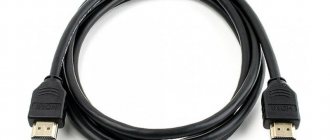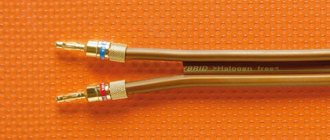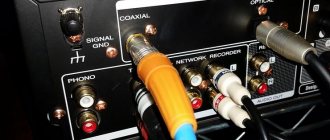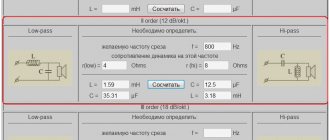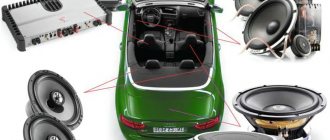Absolare Bybee Purifier surge protector. Network cable Kubala Sosna Emotion
Even twenty years ago, audio equipment developers did not attach much importance to the issues of proper nutrition. The emergence of high-resolution formats on the one hand and the increase in the level of interference in the network due to the widespread use of devices with pulse converters (computers, DVD players, flat-panel TVs, etc.) on the other, have forced us to think seriously about this problem.
Most of the interference can be eliminated by conventional network filters consisting of RF chokes and capacitors. But they cannot fully realize the potential of a high-end audio system: high detail, tonal resolution and clear focus can only be achieved if all components receive exceptionally clean power from the AC mains. With video, the result is even more clear - connect an expensive BD player and projector directly to a power outlet, then through a decent filter, and you'll immediately notice the difference. However, this topic has been raised several times in the magazine; those interested can find a lot of materials in the corresponding section on the website www.salonav.com.
Today we will test perhaps the most unusual of these devices - Absolare Bybee Purifier. Before moving on to the description of the design, I’ll tell you a little about its creator and the principles formulated in the corresponding patent.
Meet Jack Bybee, theoretical physicist, specialist in the field of quantum mechanics and superconductivity. For many years he worked for the US Navy, heading a laboratory dealing with sonars for nuclear submarines. It is clear that for such equipment the noise level is the most important indicator, and all the efforts of scientists were aimed at reducing it. The data from these studies are still classified, but after founding his own company, Bybee Technoligies, Jack Bybee got the opportunity to use them for further experiments. They led him to create a commercial product - Bybee Quantum Purifier. The principle of operation is based on the fact that after a certain treatment of the conductor (in particular, copper, silver, gold, as well as with the addition of rare earth metals), the electrons in its crystal lattice line up in the so-called. Cooper pairs, as a result of which the signal speed increases by 20 - 40%, reaching 92% of the speed of light*.
* This is the most simplified description, in reality everything is much deeper and more complex. The main thing is that Bybee's conclusions do not cause mistrust among the scientific community. For more information on how Quantum Purifier works, see https://www.bybeetech.com.
Accordingly, the reactive component of the impedance drops by the same amount, i.e. The capacitance and inductance of such cables become negligible. When transmitting digital information, there is almost completely no “ringing” or blocking of edges on a rectangular signal. The most interesting thing is that the described effect is observed even if not the entire conductor, but only part of it, is subjected to such treatment. This part is the Bybee Quantum Purifier elements - small sealed capsules with leads, very similar to old paper capacitors. They are supplied to some manufacturers of cables and surge protectors, and are also used by amateurs for tweaking audio and video equipment. Quantum cleaners are also available as RCA tips and spade cables for speaker cables. Bybee Technoligies products have been tested by several reputable publications, and all reviewers agree that their effect exceeds all expectations.
The capsules used in the Absolare surge protector are custom-made from ceramics, noble and rare earth metals (including zirconium and neodymium). Internal wiring is made with Echole cable made from an alloy of gold, silver and palladium. The metal case with rounded edges and a milled front panel serves as a screen and protects the internal elements of the filter from vibrations. On the outside, it is covered with genuine leather, as the company emphasizes, the same as that used to trim the interior of expensive BMW models. On the back wall there is a network input, a switch and six deep European standard sockets. The device is supplied in a durable aluminum case, providing reliable protection during transportation. The cost of the filter in Russia is 8900 euros.
Kubala Sosna, despite the name consonant with Slavic ears, is a purely American company. It was founded by Joe Kubala and Howard Sosna, two middle-aged gentlemen who spent most of their lives selecting High Audio components for various installations, including professional recording studios. They have also gained fame as specialists in setting up and demonstrating AV systems at specialized exhibitions. At one of these shows, they met by chance, talked and found out that they both had a couple of ideas in stock that were in demand by the market. The company's first products were network cables that Howard made for his new home - they were alarmingly obvious in improving the sound quality of amplifiers and improving the picture on the TV screen. The partners patented the OptimiZTM geometry, which is now used in almost all Kubala Sosna products. And these are several lines with the names Imagination, Anticipation, Expression, Emotion and the top Elation!, which include analog, digital, acoustic and power cables of various lengths and configurations, up to Y-splitters.
The inventors themselves say about the OptimiZTM technology: “We are very proud of it, but we prefer not to disclose details. We can only say that Kubala Sosna products are absolutely different from those of competitors.” According to the graph given on the company’s website, we can conclude that the cables simultaneously have very low linear capacitance and inductance. Which is already an outstanding achievement.
The Emotion 2.5m network cable costs $2,200. Under the soft fabric shell, a weave of three powerful multi-core conductors can be felt. Both terminals - a 16-amp European plug and a 10-amp connector - have gold-plated contacts. Despite its considerable thickness, the cable is quite flexible and will not create problems in limited space behind an equipment rack.
The network in our building is poor, mainly due to the abundance of working computers and power tools (repairs have been going on for two years now). This is why the editorial experts prefer to test equipment on weekends, when no one is working, but for testing filters, a dirty network is just what you need. To reach a verdict, I listened to several really high-quality discs, first with the source and amplifier connected directly to the wall outlet, and then through the Absolare filter with the Kubala Sosna cable described above.
In such cases, the difference is usually audible in the HF range, since network interference affects the purity of the overtones. In our example, the first impression is completely different - with the filter, the bass became deeper, as if the tone control had been turned up a little. In fact, of course, no one turned anything, and there is no tone block in the Bryston B100 SST. The feeling is purely subjective, but absolutely distinct. It is worth noting that enhancing the infrabass did not make the sound heavier, as often happens with frequency correction.
Upon closer listening, other interesting things emerged. During symphonic music [1], the hall seemed to increase in volume - the back wall moved to the rear, and with it some of the virtual sources. At the same time, their scale was slightly leveled: small ones became larger, and large ones became smaller.
With a clear abundance of air, pauses between individual sounds became clearer and the rhythmic structure of the works was easier to read. In general, the music itself turned out to be somehow closer and more understandable. By analogy with video, in such cases they usually say “the sound background has become blacker”; I can’t find a more precise definition.
But this brilliant medal also has a flip side - the digital nature of the source became more clearly evident. The vocals [2] showed roughness and an emphasis on sibilance*, which previously only slightly shaded the soft manner of performance. So selecting accessories is a complex task, and it is naive to expect that by purchasing an expensive filter or cables, you will immediately plunge into audiophile nirvana. This is just one step towards understanding the sound, which may entail replacing or tweaking other components. Some people go this route themselves, but sometimes it’s easier to entrust the selection of a system to an experienced installer.
Bybee Quantum Purifier cells are small sealed capsules with leads, much like old paper capacitors
SYSTEM
- Bryston BCD 1 CD Player ($4186)
- Integrated amplifier Bryston B100 SST ($6787)
- Legacy TL Speaker Cables ($515).
- RCA interconnect cables Acuphase Super Refined SL-10G (€455)
MUSIC WE LISTENED TO
- Tutti, “Tutti! Orchestral Sampler". 24 bit HDCD Reference Recordings, 1997
- Emi Fujita, "Camomile Best Audio". Pony Canyon, 2007
*Sibilants (from Latin sibilo - whistle), whistling, anterior lingual fricative (fricative) consonants (for example, “s”, “z”), during the formation of which an air stream passes through a narrow round gap.
share
Tags: AbsolareKubala
The company was founded by Joe Kubala and Howard Sosna - AV industry professionals, installers of High End Audio and home theater systems, who also have experience in building professional music studios - everything from the design of the room to filling it with equipment and final setup. Friends expanded their experience as consultants in the selection of components for top-class stereo systems and organizers of audio exhibitions and showrooms.
One day, while designing and building an AV system in his new home, Howard Sosna decided to try out some of his unconventional ideas regarding audio cable design. By experimenting and comparing with the best cables available to him at that time, Howard came to a result that satisfied him - the cable of his design was better than the reference samples. This pushed him to further research and experimentation over a number of years. Impressed with the result, Howard shared his work with Joe Kubala and they decided to create a cable network; they worked together on the concept, product range and tests. Long-term tests of samples in transistor and tube systems, comparisons with cables from other manufacturers, consultations with audiophiles and legends of the audio industry - as a result, the patented OptitmiZTM concept was born, which underlies all Kubala-Sosna cables.
Audio cables have come a long way towards being recognized as having a huge impact on the performance of an audio system. And some even consider cables as part of the audio system, along with speakers and amplifiers. Therefore, many enthusiasts pay great attention to the technology used when choosing cables for their audio system.
Are they right?
Here's what Joe Kubala and Howard Sosna think about it:
“We heard about the golden ratio, air and vacuum dielectrics, exotic materials and much more.
Does cable technology not matter?
With so much attention to the technologies used, it is not surprising that we are asked to talk about our technologies.
We respond with an explanation of why the answer won't matter. What? Doesn't matter? How can this be true?
When an engineer designs an audio cable, he must consider conductor material, number of conductors, overall conductor cross-section and geometry, conductor spacing, dielectric material and thickness, shielding, and much more. The sound signature of the cable is determined by the general “recipe” and depends on all of the listed factors, and not on one or two. Therefore, knowing which cable is copper or silver will not tell you about its sound (regardless of what preconceptions you have about the first and second). To form an opinion about the sound of a cable, you have to listen to it.
What is OptimiZTM?
We're very proud of our technology, although we don't talk about it much. She is already more than ten years old, and she has proven herself well.
The OptimiZTM architecture provides performance that differs from typical cables on the market. Our cables will take care of everything!
We talk about this to show that we are doing something differently and are worth listening to.
What are we doing differently?
Let's look at a simple graph that plots capacitance on one axis and inductance on the other:
What does this prove? Honestly, nothing. Even though we are different from other cables, even though the OptimiZTM architecture results in something unlike any of the 32 competing cables, it proves that we sound better. And it shows we did something differently.
Another example is the characteristic impedance plot:
Take a look at where our Emotion cable sits on it.
Can you tell from the graph that it sounds better?
It is very different from other cables, truly unique. However, we should not confuse different with better. But again, we did something differently.
Another real difference is the ability of our cables to transmit nearly perfect square waves despite load variations at one or both ends of the cable. No other cable we tested did this.
Why is this so important?
The load transferred to the cable from your CD player to your preamp is the output impedance of the CD player and the input impedance of the preamp. This means that the RevolutionZTM family of cables will perform well and not distort the original signal, no matter what components make up the system now or in the future. Is this a significant difference? Yes, sure!
In fact, our cables differ in many ways! These differences explain why we are told that our cables sound like no other!
We hope we've encouraged you to listen to Kubala-Sosna to determine for yourself whether they're right for you."
For more than fifteen years, high-end brands have chosen Kubala-Sosna to demonstrate systems at audio shows and receive rave reviews from visitors, and audio journalists regularly note the extraordinary sound quality of the cables.
But the main thing is the recognition of audiophiles. Owners of completely different systems in which Kubala-Sosna cables have found their place are attracted by their musicality combined with excellent detail, analytical accuracy and emotion.
Try and share your impressions and emotions with them!

